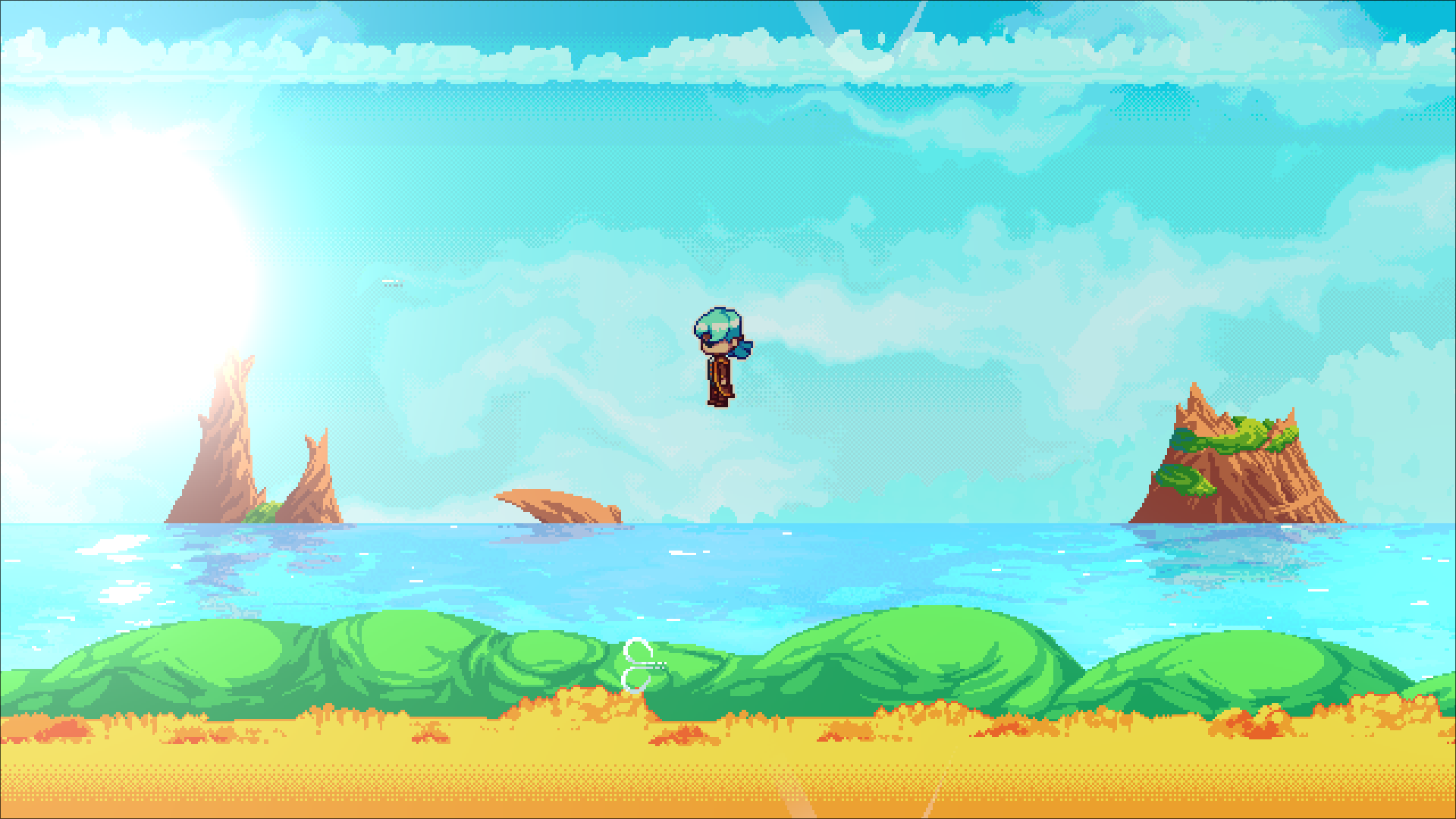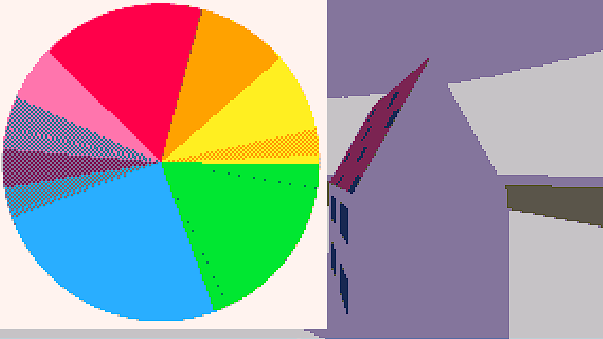Procedural Pixelated Sea Shader
Perfect for side-scroller or parallax backdrops! Assumes that you have a global uniform named `WORLD_SUN_POSITION` for the sun’s reflection across the water, that contains a vector normalized between 0-1 in terms of both its x and y components.
Here is a material with some colours and noise settings preset. Please be sure to modify it to contain the path of the shader!
“`
[gd_resource type=”ShaderMaterial” load_steps=7 format=3 uid=”uid://3yylpnpe1olk”]
[ext_resource type=”Shader” uid=”uid://4vldjefc7u33″ path=”INSERT SHADER PATH HERE” id=”1_odgra”]
[sub_resource type=”FastNoiseLite” id=”FastNoiseLite_gwerp”]
noise_type = 2
frequency = 0.04
fractal_type = 0
[sub_resource type=”NoiseTexture2D” id=”NoiseTexture2D_a3l0h”]
width = 1024
height = 1024
seamless = true
noise = SubResource(“FastNoiseLite_gwerp”)
[sub_resource type=”NoiseTexture2D” id=”NoiseTexture2D_c6jme”]
width = 1020
height = 1020
seamless = true
noise = SubResource(“FastNoiseLite_gwerp”)
[sub_resource type=”FastNoiseLite” id=”FastNoiseLite_ij666″]
fractal_type = 3
[sub_resource type=”NoiseTexture2D” id=”NoiseTexture2D_s04fh”]
width = 640
height = 640
seamless = true
noise = SubResource(“FastNoiseLite_ij666”)
[resource]
shader = ExtResource(“1_odgra”)
shader_parameter/front_colour = Color(0.254902, 0.843137, 0.843137, 1)
shader_parameter/middle_colour = Color(0.0784314, 0.627451, 0.803922, 1)
shader_parameter/back_colour = Color(0.0784314, 0.411765, 0.764706, 1)
shader_parameter/layer_distort = 0.5
shader_parameter/sin_scale = 1
shader_parameter/highlights_threshold = 0.85
shader_parameter/reflection_strength = 0.25
shader_parameter/refraction_strength = 0.08
shader_parameter/sun_refraction_scale = 0.195
shader_parameter/sun_refraction_mag_min = 0.8
shader_parameter/sun_refraction_mag_max = 0.9
shader_parameter/refraction_colour_split = 0.03
shader_parameter/godot_light_discount = 0.5
shader_parameter/layer_ID = 3
shader_parameter/height = 0.36
shader_parameter/saturation = 1.1
shader_parameter/waves = SubResource(“NoiseTexture2D_s04fh”)
shader_parameter/highlights_0 = SubResource(“NoiseTexture2D_a3l0h”)
shader_parameter/highlights_1 = SubResource(“NoiseTexture2D_c6jme”)
“`
Shader code
shader_type canvas_item;
// Global
uniform sampler2D SCREEN_TEXTURE: hint_screen_texture, filter_nearest;
global uniform vec2 WORLD_SUN_POSITION;
// Fluid
uniform vec4 front_colour: source_color;
uniform vec4 middle_colour: source_color;
uniform vec4 back_colour: source_color;
uniform float layer_distort: hint_range(0.0, 1.0) = 0.5;
uniform uint sin_scale = 1;
uniform float highlights_threshold: hint_range(0.0, 1.0) = 0.85;
uniform float reflection_strength: hint_range(0.0, 1.0) = 0.25;
uniform float refraction_strength: hint_range(0.0, 1.0) = 0.0;
uniform float sun_refraction_scale: hint_range(0.0, 1.0) = 0.195;
uniform float sun_refraction_mag_min: hint_range(0.0, 1.0) = 0.8; // Afternoon
uniform float sun_refraction_mag_max: hint_range(0.0, 1.0) = 0.9; // Sunrise/Sunset
uniform float refraction_colour_split: hint_range(0.0, 1.0) = 0.03;
uniform sampler2D waves;
uniform sampler2D highlights_0: hint_default_black;
uniform sampler2D highlights_1: hint_default_black; // This texture should be a copy of the above, with a slightly smaller resolution.
// Backdrop
uniform float height = 0.36;
uniform float saturation: hint_range(0.0, 2.0) = 1.0;
// Called for every pixel the material is visible on.
void fragment() {
// If we're above a certain height, then discard.
// Also determine the in-fluid UV.
float total_height = height; // Used to be another parameter here...
if (1.0 - UV.y > total_height)
discard;
vec2 fluid_uv = vec2(UV.x, (UV.y - (1.0 - total_height)) / (1.0 - (1.0 - total_height)));
vec2 undistorted_fluid_uv = fluid_uv;
// Distort the fluid UV.
float wave = texture(waves, undistorted_fluid_uv).r; // +-
fluid_uv.x += wave * layer_distort;
// Get the fluid's colour, which is basically two sine waves over a background colour, distorted with a noise texture.
vec4 colour = middle_colour; // TODO: Original multiplier was 10x, modified it to 2 PI for trig reasons.
float front_wave = (sin( TIME * 0.25 + fluid_uv.x * (PI * 2.0) * float(sin_scale) + 0.0) + 1.0) * 0.5;
float back_wave = (sin(-TIME * 0.25 + fluid_uv.x * (PI * 2.0) * float(sin_scale) + 0.5) + 1.0) * 0.5;
float mag = 1.0 / 3.0;
bool back_colour_used = false;
if (fluid_uv.y - mag > front_wave * mag)
colour = front_colour;
if (fluid_uv.y < back_wave * mag) {
colour = back_colour;
back_colour_used = true;
}
// Add highlights to the edges of distant waves.
float highlights_0_n = (texture(highlights_0, fract(undistorted_fluid_uv + vec2(0.0, 0.0) + TIME * vec2(-0.01, -0.01))).r + 1.0) * 0.5;
float highlights_1_n = (texture(highlights_1, fract(undistorted_fluid_uv + vec2(0.5, 0.0) + TIME * vec2( 0.01, 0.01))).r + 1.0) * 0.5;
if ((highlights_0_n + highlights_1_n) * 0.5 > highlights_threshold)
colour = vec4(1.0);
// Add screen reflections with refractions.
float refraction_0 = texture(waves, fract(undistorted_fluid_uv + TIME * vec2(-0.01, 0.0))).r;
float refraction_1 = texture(waves, fract(undistorted_fluid_uv + TIME * vec2( 0.01, 0.0))).r;
float refraction = (refraction_0 + refraction_1) * 0.5;
vec2 reflect_uv = vec2(SCREEN_UV.x, mix(1.0 - total_height, 0.0, undistorted_fluid_uv.y));
reflect_uv.x += refraction * refraction_strength;
reflect_uv.x -= refraction_strength * 0.5;
vec4 screen = texture(SCREEN_TEXTURE, reflect_uv);
colour = mix(colour, screen, reflection_strength);
// Add the sun's refraction across the surface of the fluid.
float proximity_to_sun = distance(WORLD_SUN_POSITION.x, SCREEN_UV.x);
float refraction_sun = (refraction + 1.0) * 0.5 * sun_refraction_scale;
if (refraction_sun > proximity_to_sun) {
float strength = (refraction_sun - proximity_to_sun) / (1.0 - proximity_to_sun);
float magnitude;
if (1.0 - WORLD_SUN_POSITION.y < total_height) { // Sun below horizon.
float how_far_under = (WORLD_SUN_POSITION.y - (1.0 - total_height)) / total_height;
magnitude = mix(sun_refraction_mag_max, 0.0, smoothstep(0.0, 1.0, how_far_under));
} else { // Sun above horizon.
float how_far_above = ((1.0 - total_height) - WORLD_SUN_POSITION.y);
magnitude = mix(sun_refraction_mag_max, sun_refraction_mag_min, smoothstep(0.0, 1.0, how_far_above));
}
if (strength > (1.0 - magnitude)) {
float refractivity = (strength - (1.0 - magnitude)) / (1.0 - (1.0 - magnitude));
vec4 lower_colour = front_colour;
if (back_colour_used)
lower_colour = mix(middle_colour, screen, reflection_strength);
colour = mix(lower_colour, vec4(1.0), step(refraction_colour_split, refractivity));
}
}
// SATURATION
// positive = more saturation
// negative = less saturation
// 0.0 = unchanged
// -1.0 = grayscale
// < -1.0 = color inversion
float saturation_scale = mix(-1.0, 0.0, saturation);
float average = (colour.x + colour.y + colour.z) / 3.0;
float xd = average - colour.r;
float yd = average - colour.g;
float zd = average - colour.b;
colour.r += xd * -saturation_scale;
colour.g += yd * -saturation_scale;
colour.b += zd * -saturation_scale;
COLOR = colour;
}








